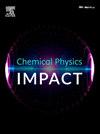水热法制备氮掺杂氧化石墨烯上的Ag2MoO4纳米颗粒,用于非对称超级电容器
IF 4.3
Q2 CHEMISTRY, PHYSICAL
引用次数: 0
摘要
能量密度和比电容是改进储能器件的两个重要参数。在这项研究中,我们将氮掺杂的还原氧化石墨烯(NRGO)引入Ag2MoO4纳米颗粒中,用于不对称超级电容器的应用。对合成的化合物进行了结构、功能、氮吸附-解吸、表面、元素分析和电化学表征。在这里,通过FESEM技术观察到AMONRGO复合材料在NRGO表面表现出Ag2MoO4的鹅卵石状结构。在1 Ag-1时,包裹有AMONRGO (II)纳米复合材料的Ni泡沫具有648 Fg-1的良好Csp。在5000次充放电循环中,它的初始电容保持率为91%。在非对称超级电容器(ASC)装置中,AMONRGO (II) || AC电极在放电速率(597.79 Wkg-1)下表现出44.13 Whkg-1的异常能量密度(Ed)。结果表明,AMONRGO电极在超级电容器中具有良好的电化学性能。本文章由计算机程序翻译,如有差异,请以英文原文为准。

Hydrothermally prepared Ag2MoO4 nanoparticles anchored on nitrogen doped rGO for asymmetric supercapacitor application
The energy density and the specific capacitance are two important parameters for improving energy storage devices. In this study, we introduce the novel incorporation of nitrogen-doped reduced graphene oxide (NRGO) into Ag2MoO4 nanoparticles, for use in asymmetric supercapacitor applications. The synthesized compounds were confirmed and characterized using structural, functional, nitrogen adsorption-desorption, surface, elemental analyses, and electrochemical properties. Here, the AMO![]() NRGO composite materials exhibited the pebble stone-like structure of Ag2MoO4 on the NRGO surface, observed by FESEM techniques. At 1 Ag-1, the Ni foam coated with the AMO
NRGO composite materials exhibited the pebble stone-like structure of Ag2MoO4 on the NRGO surface, observed by FESEM techniques. At 1 Ag-1, the Ni foam coated with the AMO![]() NRGO (II) nanocomposite demonstrates a good Csp of 648 Fg-1. It displayed retention of 91 % of its initial capacitance over 5000 charge/discharge cycles. In an asymmetric supercapacitor (ASC) device, the electrodes of AMO
NRGO (II) nanocomposite demonstrates a good Csp of 648 Fg-1. It displayed retention of 91 % of its initial capacitance over 5000 charge/discharge cycles. In an asymmetric supercapacitor (ASC) device, the electrodes of AMO![]() NRGO (II) || AC demonstrated an exceptional energy density (Ed) of 44.13 Whkg-1 at a discharge rate (597.79 Wkg-1). The results suggest that the AMO
NRGO (II) || AC demonstrated an exceptional energy density (Ed) of 44.13 Whkg-1 at a discharge rate (597.79 Wkg-1). The results suggest that the AMO![]() NRGO electrodes exhibit promising electrochemical performance for the supercapacitor application.
NRGO electrodes exhibit promising electrochemical performance for the supercapacitor application.
求助全文
通过发布文献求助,成功后即可免费获取论文全文。
去求助
来源期刊

Chemical Physics Impact
Materials Science-Materials Science (miscellaneous)
CiteScore
2.60
自引率
0.00%
发文量
65
审稿时长
46 days
 求助内容:
求助内容: 应助结果提醒方式:
应助结果提醒方式:


